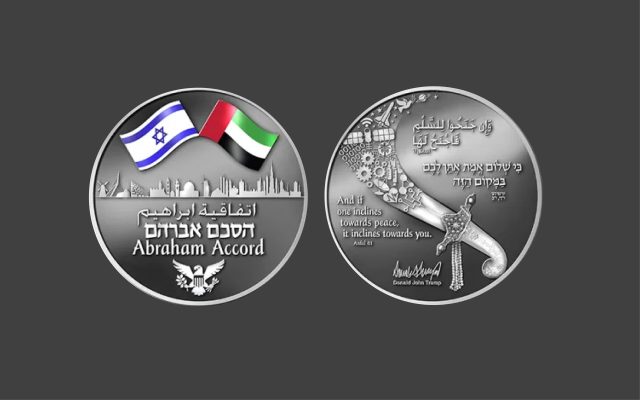Introduction:
The Abraham Accords represent a momentous peace agreement of historic proportions, forging diplomatic ties between Israel and multiple Arab nations. This landmark accord, introduced by then-U.S. President Donald Trump, marked a significant breakthrough in the normalization of relations between Israel and Arab countries, with the United Arab Emirates and Bahrain joining Israel as key participants.
Central to the Abraham Accords was the crucial recognition of Israel as a nation by Arab states. This pivotal step bore profound significance, considering Israel’s history of grappling with security concerns and hostilities from numerous Arab nations. The acknowledgment of Israel’s nationhood opened up the potential for future diplomatic relationships between Israel and other Muslim-majority countries.
It’s important to note that the Abraham Accords did not emerge in isolation; they followed earlier efforts spanning several years to broker agreements and foster stability in the tumultuous Middle East. Nonetheless, the Abraham Accords stand out as a major milestone in the ongoing quest for peace and stability in the region.
In summary, the Abraham Accords epitomize a diplomatic triumph that held the promise of reshaping Middle Eastern diplomatic dynamics. By securing recognition and acceptance from Arab nations, Israel paved the way for potential future collaborations, carrying significant implications for regional stability and cooperation.
Historical Background:
In the wake of World War I, the Sykes-Picot Agreement placed Palestine under British administration, which was previously part of the Ottoman Empire, while most other Arab regions gained their independence. The vision of a Jewish state, born in the late 19th century, culminated in the establishment of Israel in 1948 on Palestinian land. This development ignited long-standing tensions and conflicts between Israel and Arab states, primarily stemming from the issue of Palestinian self-determination.
The Yom Kippur War of 1973 saw Egypt launching an attack on Israel, drawing other Arab nations into the conflict. While the Arab coalition initially made headway, Israel ultimately received substantial support from the United States. Due to American intervention and the onset of the holy month of Ramadan, Egypt chose to end the war, resulting in the first-ever peace agreement between Israel and an Arab nation, known as the “Camp David Accords.”
This historic accord led to Israel ceding control of the Sinai Peninsula to Egypt. Anwar Sadat, Egypt’s leader at the time, took the extraordinary step of recognizing Israel as a sovereign state, setting a precedent for future diplomacy. 1
The Middle East remained in a state of flux, with attempts at peace agreements between Israel and Palestine proving unsuccessful. The Oslo Accords of 1993 and 1995 emerged, with substantial mediation from Egypt and the United States. These agreements involved the participation of the Palestine Liberation Organization (PLO) and Israeli leaders. Although the Oslo Accords played a pivotal role in fostering dialogue between Palestine and Israel, escalating tensions in the late 20th century eventually led to their collapse by 2018.
These historical events underscore the intricate and evolving nature of relationships in the Middle East, particularly those between Israel and its Arab neighbors. Various peace agreements have marked both progress and challenges in the pursuit of regional stability and peace. 2
The Abraham Accords Peace Agreement:
A secret meeting between Omani Foreign Minister Yusuf bin Alawi bin Abdullah and Israeli Prime Minister Benjamin Netanyahu hinted at a significant diplomatic shift. Following this meeting, Yusuf bin Alawi hinted at the need to view Israel as part of the Middle East, similar to other states. This alluded to a desire to establish stable relations with Israel. The official announcement of the Abraham Accords Peace Agreement came on August 13, 2020, through a joint statement by the United States, Israel, and the United Arab Emirates.
The nomenclature of the “Abraham Accords Peace Agreement” finds its roots in the shared significance of Abraham (known as Ibrahim in Islamic tradition) in both Islam and Judaism. The reverence for Abraham in both religions makes his name a symbol of unity. Subsequently, on September 15, 2020, the agreement was set in motion with a joint statement from Israel, the United Arab Emirates, and Bahrain. 3
Initially, the signatory nations of the agreement were Israel, the United Arab Emirates, and Bahrain. However, in December 2020, Morocco decided to establish relations with Israel, followed by Sudan’s signing of the Abraham Accords on January 6, 2021, expanding the circle of participating nations. Furthermore, other Arab and non-Arab Muslim countries have expressed interest in cultivating stable relations with Israel.
The Abraham Accords mark a momentous advancement in Middle Eastern diplomacy, fostering relationships between Israel and Arab nations. The name itself embodies a shared heritage that transcends religious and cultural boundaries. This agreement holds the potential to reshape regional dynamics and promote peace and cooperation throughout the Middle East. 4
Key Aspects of the Agreement:
The agreement outlines several key points for the participating countries:
1. Establishment of diplomatic relations: Signatory nations will establish diplomatic relations with Israel, including the opening of embassies and the exchange of ambassadors between their respective capitals.
2. Cooperation in Various Sectors: The agreement encourages collaboration in various sectors, including tourism, trade, health, and security. This collaboration aims to stimulate economic growth, improve healthcare services, and enhance the safety and security of the region.
3. Facilitating Religious Pilgrimage: The accord permits the facilitation of religious pilgrimages, particularly for Muslim visitors from around the world. It grants access to historical sites in Israel, including the Al-Aqsa Mosque in Jerusalem, the third holiest site in Islam, ensuring peaceful visits and worship.
4. Cultural Exchange: Beyond political and economic cooperation, the agreement emphasizes cultural exchange. This involves sharing art, technology, and fostering interfaith dialogue. The goal is to bridge gaps and promote a deeper understanding between the Islamic and Jewish traditions, sending a message to the world that Israeli and Arab relations can transcend historical divides.
The Abraham Accords represent a multifaceted diplomatic achievement, addressing not only political and economic dimensions but also cultural and religious aspects. By forging diplomatic ties and promoting cooperation across various sectors, it seeks to contribute to regional stability, prosperity, and convey a broader message of unity between Israel and Arab nations. 5
The Beginnings of Israel’s Acceptance:
The Abraham Accords Peace Agreement stands as a pivotal milestone in Israel’s quest for acceptance, particularly among Arab nations. This agreement ushers in a new era in Israel’s diplomatic engagements, with a primary focus on Arab countries. Notably, it includes key allies of Saudi Arabia, such as the United Arab Emirates, Bahrain, and Oman, among other participating nations.
According to international political analysts, achieving such a momentous agreement in the Middle East without the consent of Saudi Arabia would have seemed improbable. Saudi Arabia holds the distinction of being the most influential nation in the region, and the participation of countries aligned with Saudi Arabia underscores the paramount importance of Saudi approval. This agreement underscores the active distancing of Arab nations from the Palestinian issue, as they prioritize their individual national interests.
Examining this agreement provides insight into the Arab countries’ gradual disengagement from the broader Palestinian matter, perceiving it more as a concern specific to Palestine rather than a collective Arab predicament. However, it is crucial to recognize that the Palestinian populace has largely rejected this vision put forth by the United States, seeing these normalization agreements with Israel as primarily serving Israel’s interests rather than addressing the fundamental issues related to Palestinian rights and statehood.
It is important to acknowledge that the Palestinian people, for the most part, have not embraced these agreements, viewing them as primarily benefiting Israel. 6
Conclusion:
Based on my analysis, the geopolitical dynamics between Saudi Arabia and Iran in Western Asia provide a crucial context for comprehending the Abraham Accords Peace Agreement. The well-established division between Saudi Arabia and its allies, on one side, and Israel’s opposition to Iran, on the other, sets the stage for this agreement. Through the Abraham Accords, Israel and Saudi Arabia’s allies, including the United Arab Emirates, Bahrain, and Oman, can now collaborate to address the Iranian influence in the Middle East.
It’s essential to consider recent diplomatic shifts, notably the re-establishment of diplomatic ties between Saudi Arabia and Iran, driven partly by China’s growing presence in the region and its challenge to American dominance. China’s attempts to mediate between Saudi Arabia and Iran have implications for the region. However, a recent meeting involving Saudi Arabia, the United Arab Emirates, India, and the United States, with Israel’s participation, indicates a potential alignment among these nations to counter Iran and promote economic development in the Middle East.
Saudi Arabia holds a pivotal position in the Muslim world, and its stance toward Israel has evolved over time, shaped by its perspective on the Palestinian issue. While Saudi Arabia itself has not joined the accord, it supports its allies in normalizing relations with Israel. These agreements exemplify the rapid transformations in regional politics and economics in the Middle East.
The Abraham Accords have been celebrated in the Western world, but it’s crucial to understand that they are perceived differently in the Muslim world. Many Muslim populations, despite their leadership’s choices, continue to view the Palestinian issue as a central concern and believe that these normalization agreements primarily serve Israel’s interests. The Palestinian question remains deeply entrenched in the sentiments and aspirations of the Muslim world, and any attempt to sideline it meets with resistance.
In recent developments, the Israeli Foreign Minister has suggested that six or seven more Muslim countries are close to recognizing Israel. This statement hints at a potential shift in diplomatic relations in the Middle East. Saudi Crown Prince Bin Salman has also indicated a move towards normalizing relations with Israel, although the specifics remain undisclosed. The prospect of Saudi Arabia, a major regional player, recognizing Israel raises significant questions. The exact identities of the six or seven Muslim nations mentioned by the Israeli Foreign Minister are unclear, leaving room for speculation and analysis based on historical context and regional dynamics. 7
In conclusion, the Abraham Accords demand examination from multiple angles. While they signify a changing landscape in regional politics and economics, they do not address the deeply ingrained issue of Palestine, which continues to resonate in the Muslim world. The unfolding developments in diplomatic relations among these nations have the potential to reshape regional alliances and have far-reaching implications for the Middle East and the broader global arena. Comprehensive analysis and ongoing monitoring of the situation are essential to gain a nuanced understanding of this evolving geopolitical landscape.
___
Originally published in Rafeeq e Manzil July 2023, an urdu magazine.
About the Author
Mohd Ghalib studies Master in Politics: International and Area Studies from MMAJ Academy of International Studies, Jamia Millia Islamia.
References :
1- Norman Lowe, Mastering Modern World History
2- Jafri, T. H. (2022) Abraham Accords and the Changing Geo-political Scenario in West Asia:
Its Impact on India. International Journal of Research Publication and Reviews, 3 (2), 557-559
3- https://www.state.gov/the-abraham-accords/
4- Rehman, A. U. (2020) Causes behind the Abraham Accord and its consequences for the
Peace Process in the Middle East. The Middle East International Journal for Social Sciences
(MEIJSS), 2 (2), 73-83.
Trump‟s Foreign Policy Moments (2017 – 2020) Council on Foreign Relations
5- https://2017-2021.state.gov/the-abraham-accords/index.html
6- Azodi, Sina (2020) Why is Iran concerned about the peace agreement between the UAE and Israel
Rehman, A. U. Causes behind the Abraham Accord and its consequences for the Peace
Process in the Middle East.
Yossef. A, (2021) Regional-impact-abraham-accords. MWI Report, series no. 2, Modern
War Institutes, 1-20.7- https://www.usip.org/publications/2023/09/saudi-israel-normalization-agreement-horizon






